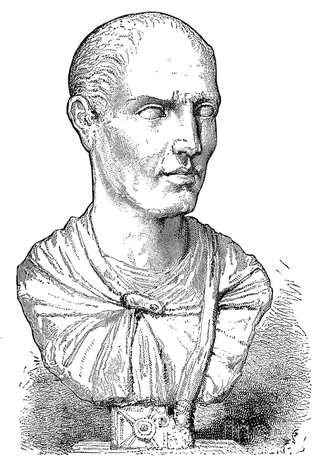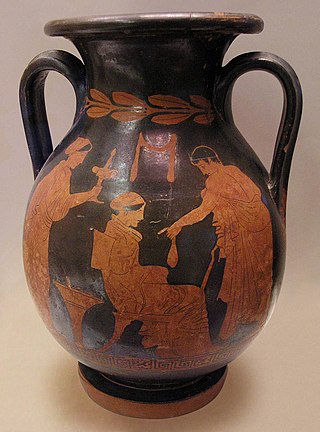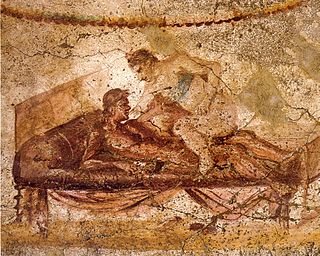Courtesan, in modern usage, is a euphemism for a "kept" mistress or prostitute, particularly one with wealthy, powerful, or influential clients. The term historically referred to a courtier, a person who attended the court of a monarch or other powerful person.

Sacred prostitution, temple prostitution, cult prostitution, and religious prostitution are rites consisting of paid intercourse performed in the context of religious worship, possibly as a form of fertility rite or divine marriage. Scholars prefer the terms "sacred sex" or "sacred sexual rites" in cases where payment for services is not involved.

Yoshiwara (吉原) was a famous yūkaku in Edo, present-day Tokyo, Japan. Established in 1617, Yoshiwara was one of three licensed and well-known red-light districts created during the early 17th century by the Tokugawa shogunate, alongside Shimabara in Kyoto in 1640 and Shinmachi in Osaka.

Lucius Licinius Lucullus was a Roman general and statesman, closely connected with Lucius Cornelius Sulla. In culmination of over 20 years of almost continuous military and government service, he conquered the eastern kingdoms in the course of the Third Mithridatic War, exhibiting extraordinary generalship in diverse situations, most famously during the Siege of Cyzicus in 73–72 BC, and at the Battle of Tigranocerta in Armenian Arzanene in 69 BC. His command style received unusually favourable attention from ancient military experts, and his campaigns appear to have been studied as examples of skillful generalship.

The hooker with a heart of gold is a stock character involving a courtesan or prostitute who possesses virtues such as integrity, generosity and kindness.

Shamhat is a female character who appears in Tablets I and II of the Epic of Gilgamesh and is mentioned in Tablet VII. She is a sacred prostitute who plays a significant role in bringing the wild man Enkidu into contact with civilization.
Paculla Annia was a Campanian priestess of Bacchus. She is known only through the Roman historian Livy's account of the introduction, growth and spread of unofficial Bacchanalia festivals, which were ferociously suppressed in 186 BC under threat of extreme penalty.

Oiran is a collective term for the highest-ranking courtesans in Japanese history, who were considered to be above common prostitutes for their more refined entertainment skills and training in the traditional arts. Divided into a number of ranks within this category, the highest rank of oiran were the tayū, who were considered to be set apart from other oiran due to their intensive training in the traditional arts. Though oiran by definition also engaged in prostitution, higher-ranking oiran had a degree of choice in which customers they took; tayū, in contrast, did not engage in sex work at all.

Portrait of a Courtesan was a painting by the Baroque master Michelangelo Merisi da Caravaggio. Painted between 1597 and 1599, it was destroyed in Berlin in 1945 and is known only from photographs. It has been suggested that the portrait represents the goddess Flora.

Prostitution was a common aspect of ancient Greece. In the more important cities, and particularly the many ports, it employed a significant number of people and represented a notable part of economic activity. It was far from being clandestine; cities did not condemn brothels, but rather only instituted regulations on them.

Prostitution in ancient Rome was legal and licensed. In ancient Rome, even Roman men of the highest social status were free to engage prostitutes of either sex without incurring moral disapproval, as long as they demonstrated self-control and moderation in the frequency and enjoyment of sex. Brothels were considered a popular place of entertainment for Roman men, and it was undoubtedly a part of the culture of ancient Rome. At the same time, the prostitutes themselves were considered shameful: most were either slaves or former slaves, or if free by birth relegated to the infames, people utterly lacking in social standing and deprived of most protections accorded to citizens under Roman law, a status they shared with actors and gladiators, all of whom, however, exerted sexual allure. Some large brothels in the 4th century, when Rome was becoming officially Christianized, seem to have been counted as tourist attractions and were possibly state-owned. There were two types of sexual slavery: patronage and prostitution. Prostitutes had to pay a tax, where patronages did not, though it was deemed more acceptable to be the latter.

Prostitution has been practiced throughout ancient and modern culture. Prostitution has been described as "the world's oldest profession" although the oldest professions are most likely farmers, hunters, and shepherds.

Elizabeth Cresswell, also known as Mother Creswell and Madam Cresswell of Clerkenwell, was one of the most successful prostitutes and brothel keepers of the English seventeenth century. Starting with houses in Bartholomew Close, in the City of London and St Leonard's, Shoreditch, she built a widespread network of brothels across London, supplied with girls and women from across England. Her employees included the wives of soldiers pressed into service for Charles II and gentlewomen who had supported the Cavalier cause during the English Civil War and had since fallen on hard times. Her bawdy houses were favoured by King Charles and his court as well as powerful figures in government and city guilds. This position gave her a measure of immunity from prosecution and added to her profile as a caricature of iniquity and corruption.

Imperia Cognati, was a Roman courtesan. She has been considered the first celebrity of the class of courtesans, which was created in Rome in the late 15th century.

Justine Paris, real name Bienfait, was a French courtesan and madam. She hosted several of the most famous brothels in mid-18th-century Paris and was one of the most known and successful of her trade. She and her brothel are portrayed in the memoirs of Casanova. She has been suggested to be the role model for the title character in Juliette by the Marquis de Sade.
Isabella de Luna was an Italian courtesan of Renaissance-era Rome. She was known as amusing company, having a kind heart but also a foul tongue. She was an accomplished musician. Amongst her patrons were members of the nobility and cardinals.
Volumnia Cytheris was an ancient Roman actress and mimae dancer. She is foremost known as the mistress of several famous Romans.
Tertia was an ancient Roman actress and dancer.
Galeria Lysistrate or Lysistrata (2nd-century) was the concubine of the Roman Emperor Antoninus Pius.
Chelidon was a Roman courtesan, famed for her influence during the praetorship of Gaius Verres.












